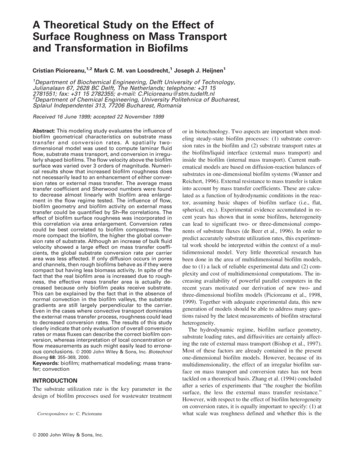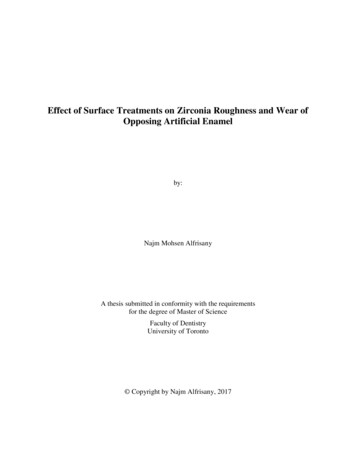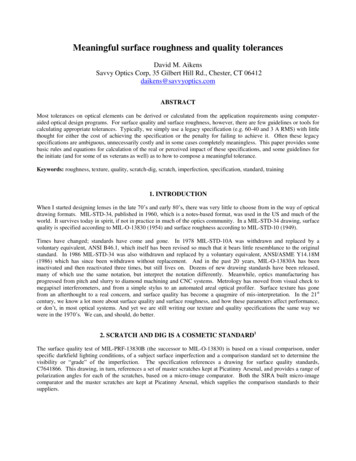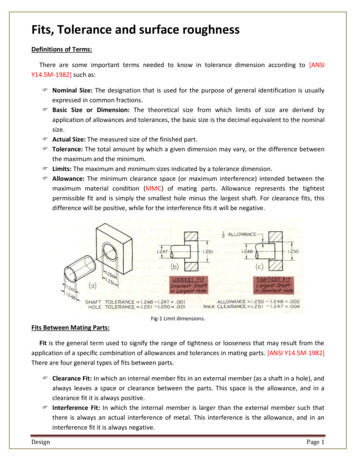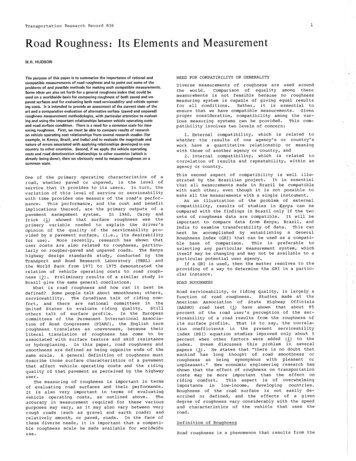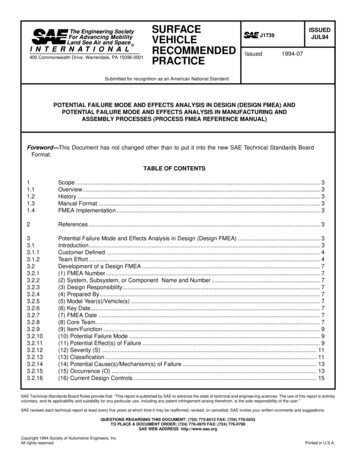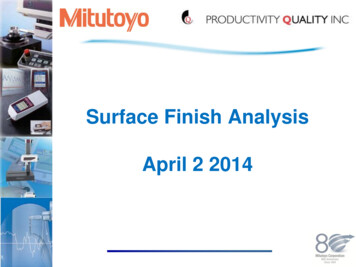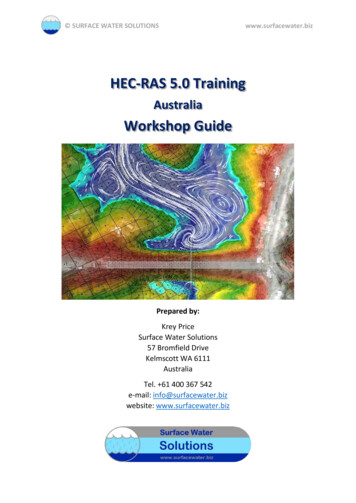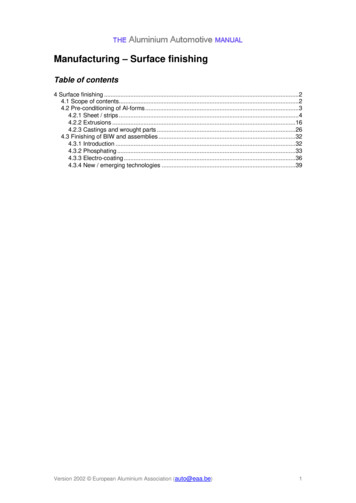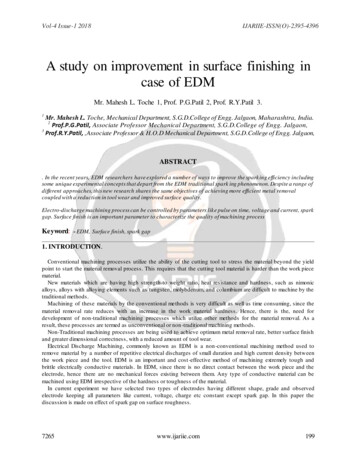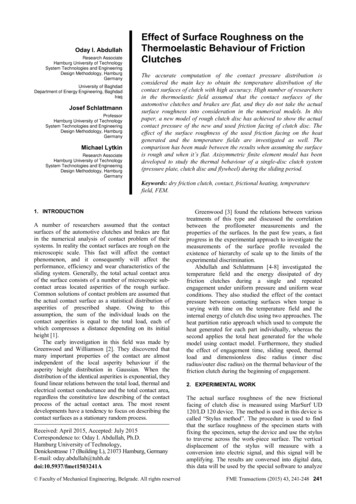
Transcription
Oday I. AbdullahResearch AssociateHamburg University of TechnologySystem Technologies and EngineeringDesign Methodology, HamburgGermanyUniversity of BaghdadDepartment of Energy Engineering, BaghdadIraqJosef SchlattmannProfessorHamburg University of TechnologySystem Technologies and EngineeringDesign Methodology, HamburgGermanyMichael LytkinResearch AssociateHamburg University of TechnologySystem Technologies and EngineeringDesign Methodology, HamburgGermanyEffect of Surface Roughness on theThermoelastic Behaviour of FrictionClutchesThe accurate computation of the contact pressure distribution isconsidered the main key to obtain the temperature distribution of thecontact surfaces of clutch with high accuracy. High number of researchersin the thermoelastic field assumed that the contact surfaces of theautomotive clutches and brakes are flat, and they do not take the actualsurface roughness into consideration in the numerical models. In thispaper, a new model of rough clutch disc has achieved to show the actualcontact pressure of the new and used friction facing of clutch disc. Theeffect of the surface roughness of the used friction facing on the heatgenerated and the temperature fields are investigated as well. Thecomparison has been made between the results when assuming the surfaceis rough and when it’s flat. Axisymmetric finite element model has beendeveloped to study the thermal behaviour of a single-disc clutch system(pressure plate, clutch disc and flywheel) during the sliding period.Keywords: dry friction clutch, contact, frictional heating, temperaturefield, FEM.1. INTRODUCTIONA number of researchers assumed that the contactsurfaces of the automotive clutches and brakes are flatin the numerical analysis of contact problem of theirsystems. In reality the contact surfaces are rough on themicroscopic scale. This fact will affect the contactphenomenon, and it consequently will affect theperformance, efficiency and wear characteristics of thesliding system. Generally, the total actual contact areaof the surface consists of a number of microscopic subcontact areas located asperities of the rough surface.Common solutions of contact problem are assumed thatthe actual contact surface as a statistical distribution ofasperities of prescribed shape. Owing to thisassumption, the sum of the individual loads on thecontact asperities is equal to the total load, each ofwhich compresses a distance depending on its initialheight [1].The early investigation in this field was made byGreenwood and Williamson [2]. They discovered thatmany important properties of the contact are almostindependent of the local asperity behaviour if theasperity height distribution in Gaussian. When thedistribution of the identical asperities is exponential, theyfound linear relations between the total load, thermal andelectrical contact conductance and the total contact area,regardless the constitutive law describing of the contactprocess of the actual contact area. The most resentdevelopments have a tendency to focus on describing thecontact surfaces as a stationary random process.Received: April 2015, Accepted: July 2015Correspondence to: Oday I. Abdullah, Ph.D.Hamburg University of Technology,Denickestrasse 17 (Building L), 21073 Hamburg, GermanyE-mail: oday.abdullah@tuhh.dedoi:10.5937/fmet1503241A Faculty of Mechanical Engineering, Belgrade. All rights reservedGreenwood [3] found the relations between varioustreatments of this type and discussed the correlationbetween the profilometer measurements and theproperties of the surfaces. In the past few years, a fastprogress in the experimental approach to investigate themeasurements of the surface profile revealed theexistence of hierarchy of scale up to the limits of theexperimental discrimination.Abdullah and Schlattmann [4-8] investigated thetemperature field and the energy dissipated of dryfriction clutches during a single and repeatedengagement under uniform pressure and uniform wearconditions. They also studied the effect of the contactpressure between contacting surfaces when torque isvarying with time on the temperature field and theinternal energy of clutch disc using two approaches. Theheat partition ratio approach which used to compute theheat generated for each part individually, whereas thesecond applies the total heat generated for the wholemodel using contact model. Furthermore, they studiedthe effect of engagement time, sliding speed, thermalload and dimensionless disc radius (inner discradius/outer disc radius) on the thermal behaviour of thefriction clutch during the beginning of engagement.2. EXPERIMENTAL WORKThe actual surface roughness of the new frictionalfacing of clutch disc is measured using MarSurf UD120/LD 120 device. The method is used in this device iscalled “Stylus method”. The procedure is used to findthat the surface roughness of the specimen starts withfixing the specimen, setup the device and use the stylusto traverse across the work-piece surface. The verticaldisplacement of the stylus will measure with aconversion into electric signal, and this signal will beamplifying. The results are conversed into digital data,this data will be used by the special software to analyzeFME Transactions (2015) 43, 241-248 241
this data to present the surface profile and calculate thestandard roughness parameters. Figure 1 shows MarSurfUD 120/LD 120 device which used to measure thesurface roughness. Also, Figure 1 shows the surfaceroughness with disc radius for three samples at differentlocations of the frictional facing.Where Ra is the arithmetical mean deviation of theroughness profile, Rz is the maximum height of theroughness profile, Rmax is the maximum roughnessdepth, and Rt is the maximum distance between thehighest peak and lowest groove over a specifieddistance. It can be seen from this figure that the surfaceroughness at each location has different behaviour. Thedifferences between the values of the standardroughness parameters are, however, small.however coupled to each other since the contactpressure from the first model is needed to define thefrictional heat flux for the second model. Furthermore,the temperature field from the thermal model is requiredfor computation of the contact pressure from the elasticmodel for the next load step. To account for thecoupling and variation of the sliding speed with time,clutch engagement time is divided into small time steps.At each time step, the instantaneous nodal temperaturesare used in the elastic contact model to determine thecontact pressure distribution. The pressure distributionis assumed to remain constant during subsequent time.A transient finite element simulation is developedfor axisymmetric thermoelastic contact problem of asingle-disc dry clutches.Figure 2 shows the flowchart of the finite elementsimulation of a coupled field problem of clutches. If thetemperature field T (x, y, z, t) is known, thethermoelastic contact problem can be solved to obtainthe contact pressure p (x, y, t). The heat generated due tofriction is:3. FINITE ELEMENT FORMULATIONIn this paper, the sequentially coupled thermalmechanical approach will be used to study the thermomechanical behaviour of a single-disc clutch. Thesequentially coupled thermal-mechanical approach usedtwo different models. One is used to solve the elasticproblem to yield the displacement field and the contactpressure distribution whereas the other model is used tosolve the transient thermal problem to account for thechange in the temperature field. Both models areqf μ pVs ,(1)where: μ is the coefficient of friction, p is the contactpressure, and Vs is the sliding speed between the clutchparts.Ra 11.78 μm, Rz 106.43 μm, Rmax 135.31 μm, Rt 171.24 μm0.60.45Height [mm]Friction facing0.30.1504045505560657075Disc radius [mm](sample-1)Ra 13.02 μm, Rz 114.57 μm, Rmax 191.85 μm, Rt 191.85 μm0.60.450.45Height [mm]Height [mm]Ra 11.34, Rz 101.17 , Rmax 130.53, Rt 139.320.60.30.1500.30.154045505560Disc radius [mm](sample-2)65707504045505560657075Disc radius [mm](sample-3)Figure 1. The details of MarSurf UD 120/LD 120 device and the measured surface roughness of the frictional facing242 VOL. 43, No 3, 2015FME Transactions
Thermoelastic analysis(t0 0) Geometry and model specifications Material properties Initial conditions {temperature, time step (Δt), initial relative sliding velocity}Start with elastic modelCalculate the contact pressure of clutch discEnd of elastic analysisti ti-1 Δtwhere i is the load step number andi 1, 2, 3, 4, .Calculate the heat flux at particular timeStart with thermal modelUse the temperature distribution of clutchsystem as an initial condition for next loadstepCalculate the temperature field of clutchsystem (flywheel, clutch disc and pressureplate) during the time stepEnd of the thermal analysisNoRelative slidingvelocity 0YesEnd of thermoelastic analysisFigure 2. Flowchart of finite element simulation of sequentially coupled thermal-mechanical approach [10]The contact pressure in (1) can be defined as the setof nodal contact forces. Therefore, the frictional heatingqf can be represented by the heat sources at nodes.These data is used as an input into the thermal finiteelement simulation. The next step of this procedure isthe heat conduction equation represented by the thermalmodel, which can be solved to obtain the newtemperature field T (x, y, z, t Δt) of the system. Inmodelling of contact problems, a special attention isrequired because the actual contact area between thecontacting bodies is usually not known beforehand. Incontact problems, unlike other boundary problems,nodes on the contact surface do not have prescribeddisplacements or tractions. Instead, they must satisfytwo relationships: (1) Continuity of normaldisplacements on the contact surface (no overlapcondition of contact area); (2) Equilibrium conditions(equal and opposite tractions).FME TransactionsEven if the contacting bodies are linear materials,contact problems are nonlinear because the contact areadoes not change linearly with the applied load.Accordingly, iterative or incremental schemes areneeded to obtain accurate solutions of contact problems.The iterations to obtain the actual contact surface arefinished when all of these conditions are met [11].Figure 3 shows the interfaces of two adjacentsubregions i and j of elastic bodies. The elastic contactproblem is treated as quasi-static with standardunilateral contact conditions at the interfaces.The following constraint conditions of displacementsare imposed on each interface:wi w j , if p 0(2)wi w j , if p 0 ,(3)where: p is the normal pressure on the friction surfaces.VOL. 43, No 3, 2015 243
The radial component of the sliding speed resultingfrom the deformations is considerably smaller than thecircumferential component. Therefore, the frictionalforces in radial direction on the friction surfaces aredisregarded in this study [12]. Figure 3b shows thermalphenomena of two adjacent subregions of bodies. Theinterfacial thermal boundary conditions depend on thestate of mechanical contact. Two unknown terms qni andqnj exist on each interface. In order to fully define theheat transfer problem, two additional conditions arerequired on each contact interface. If the surfaces are incontact, the temperature continuity condition and theheat balance condition are imposed on each interface:Ti T j , if p 0 ,(4)qf μprω qn (qni qnj ) , if p 0 , (5)where: ω is the angular sliding speed.(a)subregion jujwi wjuisubregion i(b)subregion jqnjqniTjTisubregion iFigure 3. Contact model for: (a) elastic and (b) transientthermal problem in two adjacent subregionsUsing the aforementioned conditions, equations ofone node from each pair of contact nodes are removed.If the surfaces are not in contact, the separated surfacesare treated as an adiabatic condition:qf 0 qni qnj , if p 0 .(6)Distribution of normal pressure p in (5) can beobtained by solving the mechanical problem occurringin the clutch disc. Assume the sliding angular speeddecreases linearly with time as:tω (t ) ωo (1 ) , 0 t ts ,ts(7)where: ωo is the initial sliding angular speed when theclutch starts to slip (t 0).A mesh sensitivity study was done to choose theoptimum mesh from computational accuracy point of244 VOL. 43, No 3, 2015view. The full Newton-Raphson with unsymmetricmatrices of elements used in this analysis assuming alarge-deflection effect. In all computations for thefriction clutch model, material has been assumed ahomogeneous and isotropic material and all parametersand material properties are listed in Table 1. Analysis isconducted by assuming there are no cracks in thecontact surfaces. Axisymmetric finite element model ofa single-disc clutch system with boundary conditions isshown in Figure 4. In this model, the surfaces of clutchdisc are considered rough.Table 1. The properties of materials and operationsParametersValuesInner radius of friction material and axial cushion,ri [m]0.035Outer radius of friction material and axial cushion,ro [m]0.08Thickness of friction material, tl [m]0.0035Thickness of the axial cushion, taxi [m]0.002Inner radius of pressure plate, rip [m]0.03Outer radius of pressure plate, rop [m]0.085Thickness of the pressure plate, tp [m]0.01018Inner radius of flywheel, rif [m]0.01Outer radius of flywheel, rof [m]0.095Thickness of the flywheel, tf [m]0.0358Applied pressure, pa [MPa]1Coefficient of friction, μ0.2Number of friction surfaces, np2Initial angular sliding speed, ωo [rad/s]300Young’s modulus of friction material, El [GPa]0.3Young’s modulus of pressure plate, flywheel andaxial cushion, Ep, Ef, and Eaxi [GPa]210Poisson’s ratio of friction material, νl0.25Poisson’s ratio of pressure plate, flywheel andaxial cushion, vp, vf, and vaxi0.28Density of friction material, ρl [kg/m3]2000Density of pressure plate, flywheel and axialcushion, ρp, ρf, and ρaxi [kg/m3]7800Conductivity of frictio
that the surface roughness of the specimen starts with fixing the specimen, setup the device and use the stylus to traverse across the work-piece surface. The vertical displacement of the stylus will measure with a conversion into electric signal, and this signal will be amplifying. The results are conversed into digital data, this data will be used by the special software to analyze . 242 VOL .
